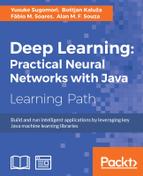In this chapter, we present a neural network architecture that is suitable for unsupervised learning: self-organizing maps, also known as Kohonen networks. This particular type of neural network is able to categorize records of data without any target output or find a representation of the data in a smaller dimension. Throughout this chapter, we are going to explore how this is achieved, as well as examples to attest to its capacity. The subtopics of this chapter are as follows:
- Neural networks unsupervised learning
- Competitive learning
- Kohonen self-organizing maps
- One-dimensional SOMs
- Two-dimensional SOMs
- Problems solved with unsupervised learning
- Java implementation
- Data visualization
- Practical problems
In Chapter 2, Getting Neural Networks to Learn we've been acquainted with unsupervised learning, and now we are going to explore the features of this learning paradigm in more detail. The mission of unsupervised learning algorithms is to find patterns in datasets, where the parameters (weights in the case of neural networks) are adjusted without any error measure (there are no target values).
While the supervised algorithms provide an output comparable to the dataset that was presented, the unsupervised algorithms do not need to know the output values. The fundamentals of unsupervised learning are inspired by the fact that, in neurology, similar stimuli produce similar responses. So applying this to artificial neural networks, we can say that similar data produces similar outputs, so those outputs can be grouped or clustered.
Although this learning may be used in other mathematical fields, such as statistics, its core functionality is intended and designed for machine learning problems such as data mining, pattern recognition, and so on. Neural networks are a subfield in the machine learning discipline, and provided that their structure allows iterative learning, they serve as a good framework to apply this concept to.
Most of unsupervised learning applications are aimed at clustering tasks, which means that similar data points are to be clustered together, while different data points form different clusters. Also, one application that unsupervised learning is suitable for is dimensionality reduction or data compression, as long as simpler and smaller representations of the data can be found among huge datasets.
